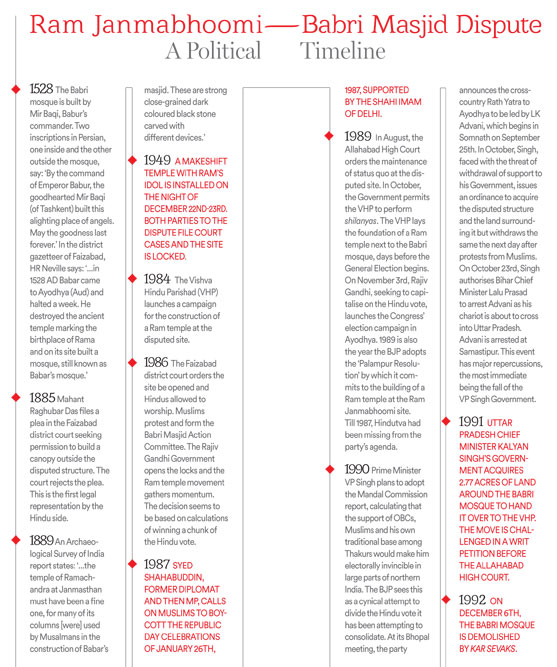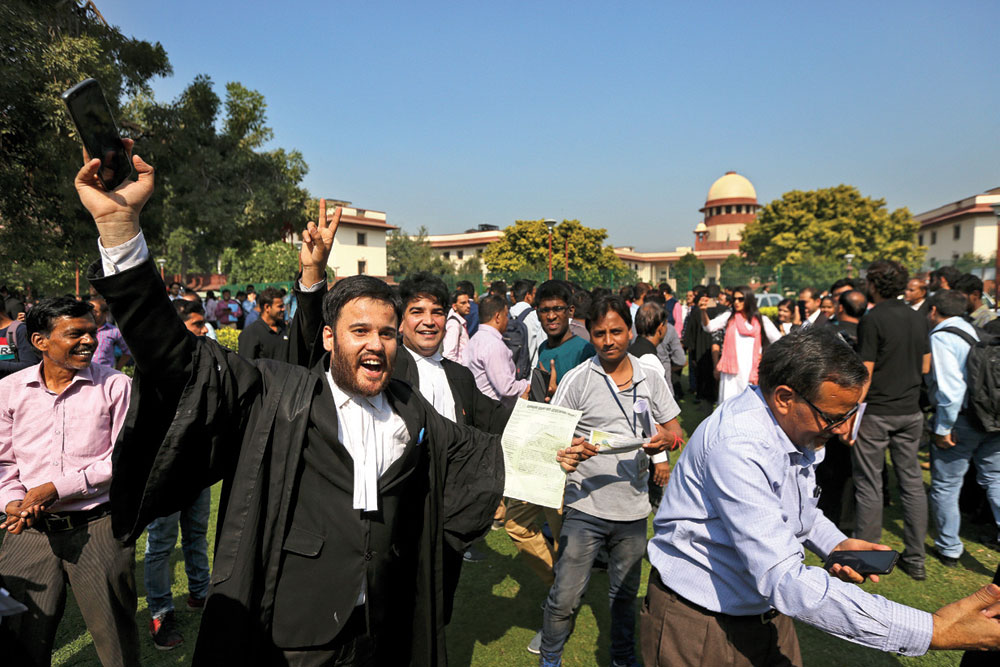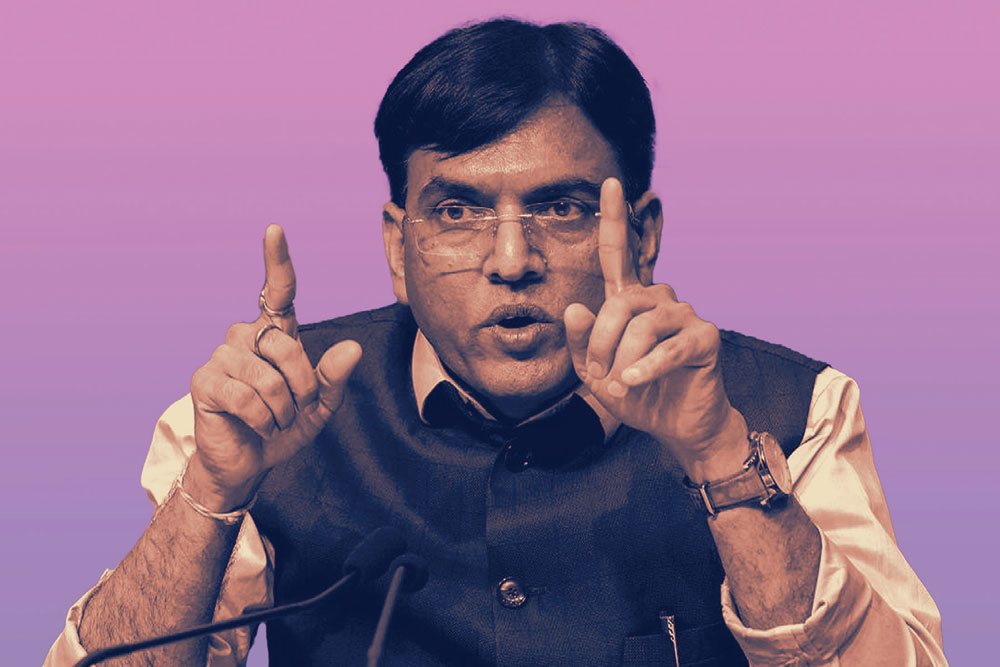The Eternity of the Deity
The court has looked at a concept deeply rooted in the spiritual traditions of this land through the prism of English and Roman law
 J Sai Deepak
J Sai Deepak
 J Sai Deepak
J Sai Deepak
 |
15 Nov, 2019
|
15 Nov, 2019
/wp-content/uploads/2019/11/EternityDeity1.jpg)
(Illustration: Saurabh Singh)
The much-awaited Ayodhya verdict was finally pronounced on November 9th, 2019 by a Constitution Bench of the Supreme Court headed by the outgoing Chief Justice of India, Ranjan Gogoi. The 929-page decision, over 807 paragraphs (including the acknowledgements and excluding the addenda), was unanimous.
Here is a summary of the outcome:
– The suit instituted by the Nirmohi Akhara as shebaits of the presiding deity, Shri Ram Lalla Virajman, was dismissed on the ground that it was barred by limitation
– The suit instituted by the Sunni Central Waqf Board was held to be within limitation. However, the court held that the board had failed to prove both limbs of its case, namely (a) that the erstwhile disputed structure (the so-called Babri Masjid) was a Waqf property owing to its use by members of the Muslim community as a mosque, and (b) in the alternative, that the Muslim community had perfected its title over the land through adverse possession, that is, being in continuous, open and peaceful possession of a property which belongs to another. Despite concluding that neither of the above limbs had been established by the board, the court exercised its powers under Article 142 and directed the allotment of five acres of land to the board for construction of a mosque which could be allocated either by the Central Government from the land acquired under the Acquisition of Certain Area at Ayodhya Act, 1993 or by the state government in Ayodhya
– The hitherto disputed piece of land has been directed to be handed over to the presiding deity, who, as a plaintiff himself, was represented in the proceedings by a next friend. The court has directed that a trust be formed to give effect to the scheme to be framed by the Central Government for the construction of the Ram temple and all connected matters. The court has further directed that members of the Nirmohi Akhara, given their status as shebaits of Shri Ram Lalla, be included in said trust.
While there are many aspects of the verdict which merit a detailed discussion, the focus of this article is limited to the verdict’s treatment of the legal character of a Hindu deity, given its manifest relevance to issues concerning Hindu places of worship.
The very idea of a Hindu deity being treated as a juristic person—a legal person in the eyes of law and a real person as a matter of faith—has been the subject of many uninformed discussions in urban and deracinated circles which ridiculed the idea as being superstitious and beyond the pale of justiciability. This very issue is one of the central questions the court has grappled with in the Ayodhya verdict in 134 paragraphs (Paragraphs 86-205 and 412-425).
Surprisingly, or perhaps not, the court has deemed it fit to look at a concept deeply rooted in the spiritual traditions of this land through the prism of English and Roman jurisprudence, instead of drawing on the vast ocean of Indic philosophy and legal thought. Instead of referring to and relying upon authoritative works on Hindu law that shed light on its evolution and application before the coming of the British, the court has sought to validate the vesting of legal personage in a Hindu murti using judgments authored by English judges and by comparison with Roman law. (As an important aside, the word ‘idol’, being a poor, pejorative and derogatory translation of murti/vigraha, is best avoided when referring to icons of Hindu deities. The word ‘icon’ may be better.)

At a time when even branches of science, such as mathematics, are beginning to understand the value of ethnomathematics, which is the study of the relationship between mathematics and culture—since each culture’s approach to science draws heavily on its conceptions of the supreme being and its relationship with the universe and the individual—it boggles the mind that in the realms of spirituality, faith and law, the apex court has sought to validate a thoroughly dharmic concept by applying the yardsticks of English and Roman law. Perhaps, this points to the deeper and larger issue at the heart of the ideological tussle playing itself out at every level. This also reinforces the need to decolonise the Indian education system, particularly legal education and the very conceptual foundations of the Indian legal system that refuse to overthrow the colonial yoke even when discussing thoroughly indigenous ideas. Rest assured, the irony of this grievance being expressed in English is not lost on the author.
Coming back to the verdict, the court has somehow managed to reconcile its Anglicised and Romanised approach with the vesting of legal character in a Hindu deity and its murti. It has observed that ‘the conferral of legal personality on things other than natural persons is a legal development which is so well recognised that it receives little exposition by courts today’. In other words, it is not out of the ordinary or uncommon, let alone being unusual or unsound, for legal systems to vest legal personage on ‘non-natural persons’. To support its point, the court has offered examples of corporations and even ships being cloaked with legal personalities to give effect to the purpose of their creation, such as facilitating transactional convenience or fulfilling a commercial necessity.
While the rationale behind citing corporations and ships being vested with legal personalities appears to have been to explain the concept of a juristic personality, it must be appreciated that not all vesting of juristic personality, particularly in the context of Hindu deities, stems from the need to fulfil a transactional or commercial necessity. In the case of a Hindu deity, vesting of juristic personality in the deity and its murti must necessarily draw primarily from the reservoir of Hindu thought behind such mode of worship and the significance of the ritual of consecration or prana pratishthana, which is to infuse life and spirit into the murti. That such personification also lends itself to the creation of jural relations and aids in the recognition of legal endowments to the deity and the temple is no doubt practical and convenient, but is undoubtedly consequential and not causal.
Unfortunately, the court’s approach puts the cart before the horse. It has viewed the Hindu idea of personification of a deity as a useful complement to the primary objective of providing a conceptual framework to deal with disputes relating to religious endowments and properties of the temple. No wonder, the court has traced the origins of the vesting of legal personality in Hindu deities, specifically in murtis of Hindu deities, only to English judges in 1888, as part of their attempts to apply Hindu law to deal with disputes relating to religious endowments. This is evident in the following excerpt from the judgment (paragraph 108): ‘The Hindu practice of dedicating properties to Temples and idols had to be adjudicated upon by courts for the first time in the late nineteenth century. The doctrine that Hindu idols possess a distinct legal personality was adopted by English judges in India faced with the task of applying Hindu law to religious endowments. Property disputes arose and fuelled questions about the ownership of the properties. Two clear interests were recognised as subjects of legal protection. First, there existed the real possibility of maladministration by the shebaits (i.e. managers) where land endowed for a particular pious purpose, ordinarily to the worship of an idol, was poorly administered or even alienated. Second, where the land was dedicated to public worship, there existed the threat that access or other religious benefits would be denied to the public, in particular to the devotees. Where the original founder of the endowment was not alive and the shebait was not the owner of the lands, how were the courts (and through them the State) to give effect to the original dedication? To provide courts with a conceptual framework within which they could analyse and practically adjudicate upon disputes involving competing claims over endowed properties, courts recognised the legal personality of the Hindu idol. It was a legal innovation necessitated by historical circumstances, the gap in the existing law and by considerations of convenience. It had the added advantage of conferring legal personality on an object that within Hinduism had long been subject to personification. The exact contours of the legal personality so conferred are of relevance to the present case to which this judgement now adverts…’

Simply put, according to the court, the spiritual genius behind the Hindu idea of personification of a deity is merely an ‘added advantage’ which aids the ‘primary purpose’ of providing a conceptual framework to courts for dispute resolution in matters of religious endowment. One of the most defining features of Hindu spiritual thought has been reduced to an ‘added advantage’ for adjudication of legal disputes. Notwithstanding the outcome in the verdict, this is precisely the kind of approach that needs to be addressed with reformative zeal before it affects indigenous rights and way of life in ways one would have never thought possible or conceivable in independent India after the departure of the colonisers.
The court has held that from a practical standpoint, the rationale behind vesting deities with legal character is to protect the interest of the devotees who put faith in the deity and who dedicate or commit material resources as endowments to the deity and the community. It has taken the view that the murti represents the ‘pious purpose’ or the spiritual purpose of the devotees. Therefore, it is legally indestructible even if it is physically destroyed by forces of nature or history since it continues to exist in law owing to the faith of the devotees which sustains the pious purpose. In other words, the deity exists for eternity even if the murti is destroyed and the ownership of the abode of the deity remains with it.
Notwithstanding the court’s view that these principles were primarily evolved to prevent mismanagement of religious and charitable endowments and to secure the interest of the devotees, it would not be unreasonable to extend the same principle to equally or even more valid contexts such as preserving the sanctity of the abode of the deity, the traditions and practices associated with the nature of the deity. After all, if the law recognises the need to protect the pious intent behind an endowment, it must follow that it recognises or must recognise with greater vigour the need to protect the sanctity and sentiment associated with the deity and its abode, namely the temple, as well as the attendant traditions and practices which contribute to the preservation of that sanctity. In other words, when fundamental rights of a deity are asserted as a legal person, these echo in the fundamental rights of the devotees to preserve the sanctity of the deity and its abode. The deity’s rights are asserted through its shebait and devotees.
The fact that fundamental rights can be enjoyed and asserted even by juristic persons has been accepted by six out of nine judges of the Supreme Court in State Trading Corporation of India Ltd vs Commercial Tax Officer and Ors (1964) (4 SCR 99), who held: ‘Part III of the Constitution deals with Fundamental Rights. Some fundamental rights are available to “any person”, whereas other fundamental rights can be available only to “all citizens”. “Equality before the law” or “equal protection of the laws” within the territory of India is available to any person (Art. 14). The protection against the enforcement of ex-post-facto laws or against double-jeopardy or against compulsion of -self-incrimination is available to all persons (Art. 20); so is the protection of life and personal liberty under Art. 21 and protection against arrest and detention in certain cases, under Art.22. Similarly, freedom of conscience and free profession, practice and propagation of religion are guaranteed to all persons. Under Art. 27, no person shall be compelled to pay any taxes for the promotion and maintenance of any particular religious denomination. All persons have been guaranteed the freedom to attend or not to attend religious instructions or religious worship in certain educational institutions (Art. 28). And, finally, no person shall be deprived of his property save by authority of law and no property shall be compulsorily acquired or requisitioned except in accordance with law, as contemplated by Art. 31. These, in general terms, without going into the details of the limitations and restrictions provided for by the Constitution, are the fundamental rights which are available to any person irrespective of whether he is a citizen of India or an alien or whether a natural or an artificial person.’
The court’s approach puts the cart before the horse. It has viewed the Hindu idea of personification of a deity as a useful complement to the primary objective of providing a conceptual framework to deal with disputes relating to religious endowments and properties of the temple
In view of this settled legal position, at the very least it could be argued that rights enjoyed by corporations and their stakeholders to preserve their autonomy and prevent the state’s intrusion are equally available to temples and devotees.
Coming back to the limitations of the court’s approach to vesting of legal character in subjects of worship, they truly come to the fore when tested against the arguments of senior advocates K Parasaran and CS Vaidyanathan, who contended that apart from the deity, Shri Ram Lalla having a juristic personality, the Ramjanmasthan itself was an object of worship of devotees, and therefore was equally deserving of treatment as a deity and hence as a juristic person. A mountain of case law was cited to advance the principle underlying the argument.
However, the court rejected the argument as well as the case law, on the ground that there was no precedent for treatment of immovable property as a deity and therefore as a juristic person. It reiterated its position that recognition of the legal character of deities was primarily from the standpoint of protecting the beneficial interest of worshippers and to evolve a legal framework for it. Further, it held that such treatment solely on the basis of the faith of devotees would rob the immovable property of all its legal characteristics as immovable property, particularly because there was no way of identifying the metes and bounds of the property. Strangely, the court also observed that such treatment would somehow go against the spirit of secularism in the Constitution since legal recognition of such a position would defeat the competing claims of the followers of other faiths.
None of the court’s reasons for rejecting the argument holds water, in this writer’s humble opinion. If, according to the court’s own logic, the entire premise of vesting of juristic personality in objects is based on necessity, there is nothing in law which prevents the vesting of such character in immovable property, or limits the scope of such vesting only to moveable property or murtis. In other words, the religious and legal necessities which justify vesting of legal character in Hindu deities are equally applicable to the Ramjanmasthan. There is no basis to bestow one with a juristic personality and deny the other. Second, the court has failed to strike a distinction between the property on which the abode of the deity is situated on the one hand and the properties held by the deity or in the deity’s name on the other. The former, especially if it happens to be a place of special significance such as the birthplace of Shri Ram Lalla, qualifies for treatment as a deity, which is distinct from the latter category of properties and endowed real estate held in the deity’s name.
Third, just as a deity can sue and be sued if it happens to be a murti, so can the immovable property if it is treated as a deity. In other words, the law has by and large treated the deity on a par with any other legal person and has not created any special exceptions in its favour. Therefore, the fear that the treatment of immovable property as deity would place it outside the reach of the law is an unfounded apprehension. Fourth, to assume that the metes and bounds of a piece of immovable property are incapable of being identified is unheard of and surprising.
Fifth, if secularism is the touchstone for according legal sanctity to beliefs, one wonders what the position of the Constitution and the Indian brand of secularism is with respect to beliefs that expressly take the position that ‘polytheism’ and ‘idol worship’ are ‘satanic’. In any case, in dealing with two competing and mutually exclusive claims on property based on diametrically opposite faith systems, the touchstones would be facts and logic, as opposed to the shifting and subjective sands of secularism. For instance, in applying the court’s own position that a deity is indestructible even if the murti is destroyed by nature or history, if a pre-existing place of worship dedicated to an indestructible deity is demolished along with the murti, and the place of prayer of another faith is constructed on top of the demolished structure, can it not be held that, first, in view of the fact that the pre-existing place of worship was dedicated to an indestructible deity whose ownership of its abode (the land which is a deity) is eternal, second, coupled with the fact that the subsequent structure was built on top of the demolished structure, facts, logic and justice demand that the land (deity) be returned to its original owner, namely the indestructible deity?
It is evident from the above that bringing in secularism to decide such disputes, which require one to objectively examine facts, only muddles the process and reasoning of adjudication. Importantly, commitment to secular values also requires us to acknowledge the limits of its application, especially to fact-based disputes, failing which the rigour of adjudication and the ability to examine uncomfortable and politically incorrect facts of history will be the primary casualties, which appears to be the case with the Ayodhya verdict. After all, the Supreme Court’s motto is Yato Dharmastato Jayah, which means where there is righteousness, there is victory. One assumes that righteousness lies in commitment to facts and not to an undefined concept, such as secularism, which keeps changing its colours like a chameleon.

/wp-content/uploads/2025/06/Cover-OpenMinds2025.jpg)












More Columns
'Gaza: Doctors Under Attack' lifts the veil on crimes against humanity Ullekh NP
Armed with ILO data, India will seek inclusion of social security in FTAs Rajeev Deshpande
Elon Musk Returns to Rebellion Mode Against Trump Open